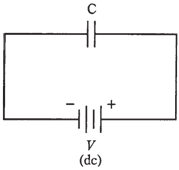Capacitors and direct current:
Assume that you have 2 big, flat metal plates, both of which are good electrical conductors. Imagine that you stack them, with only air in between. What will take place if you connect the source of direct current across the plates. The plates will become charged electrically, and will reach the potential difference equal to the direct current source voltage. It will not matter how big or small the plates are; their mutual voltage will always be the same as that of source, although, if the plates are large, it might take some time for them to become fully charged. The current, once the plates are charged, will become zero.

Figure-- A capacitor connected across a source of dc.
If you put some insulating material, like glass, between the plates, their mutual voltage won't change, although the charging time may increase.
If you increase the source voltage, potential difference between plates will follow along, more or less frequently, depending on how large the plates are and on what is between them. If voltage is increased without any limit, arcing will take place eventually. That is, sparks will begin to jump between plates.